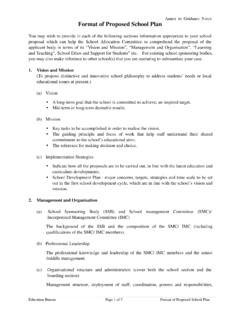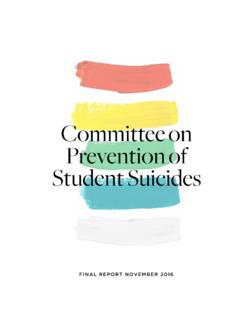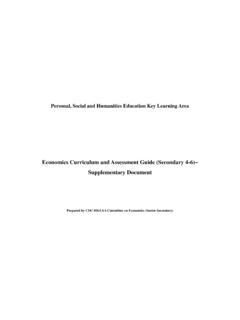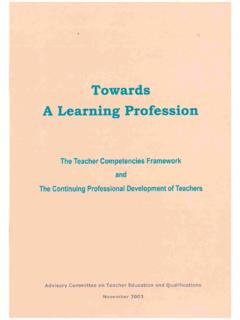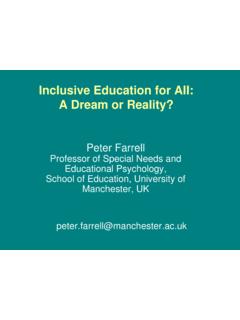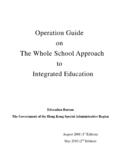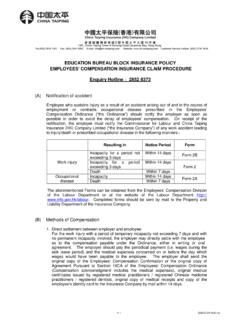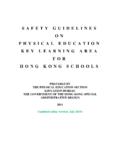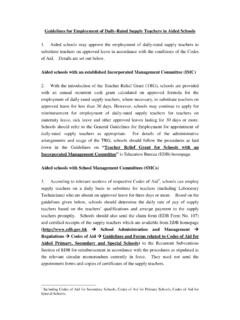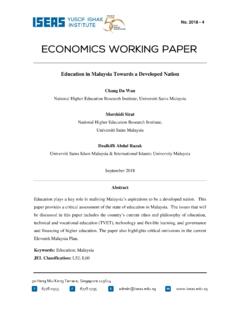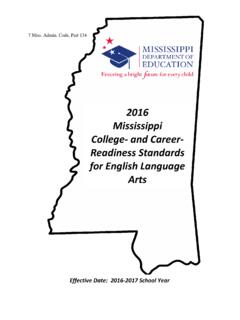Transcription of Mathematics Education - Home - Education Bureau
1 Prepared byThe Curriculum Development CouncilRecommended for use in schools byThe Education BureauHKSARG20172017 Mathematics Education Key Learning Area Curriculum Guide (Primary 1 secondary 6) Mathematics EducationKey Learning Area Curriculum Guide(Primary 1 secondary 6) Mathematics Education Key Learning Area Curriculum Guide (Primary 1 secondary 6) Prepared by the Curriculum Development Council i Preambles The development of the Hong Kong school curriculum has advanced into a new phase of ongoing renewal and updating. It ushers in a new era for curriculum development to keep abreast of the macro and dynamic changes in various aspects in the local, regional and global landscapes in maintaining the competitiveness of Hong Kong. For the ultimate benefits of our students , schools are encouraged to sustain and deepen the accomplishments achieved since the Learning to Learn curriculum reform started in 2001, and to place new emphases on future needs in curriculum development for achieving the overall aims and learning goals of the school curriculum.
2 The eight Key Learning Area (KLA) Curriculum Guides (Primary 1 - secondary 6) have been updated and recommended by the Curriculum Development Council (CDC)1 to support the ongoing renewal of the school curriculum at the primary and secondary levels. In updating the KLA Curriculum Guides, the respective KLA committees under the CDC have taken into consideration the concerns, needs and suggestions of various key stakeholders including schools, principals, teachers, students and the public at large. A series of school briefing cum feedback collection sessions coupled with a territory-wide school survey were conducted in 2015 to gauge schools views on the major updates of the respective Curriculum Guides. The eight KLA Curriculum Guides ( 2017 ) supersede the 2002 versions.
3 Each KLA Curriculum Guide presents the updated curriculum framework which specifies the KLA s curriculum aims, learning targets and objectives, delineates the direction of ongoing curriculum development at the KLA level, and provides suggestions on curriculum planning, learning and teaching strategies, assessment, as well as useful learning and teaching resources. In addition, updated examples of effective learning, teaching and assessment practices are provided for schools reference. Supplements to some KLA Curriculum Guides and subject curriculum guides are also available to provide further suggestions on their implementation at specific key stages. Schools are encouraged to adopt the recommendations in the KLA Curriculum Guides, taking into account the school contexts, teachers readiness and learning needs of their students .
4 1 The CDC is an advisory body offering recommendations to the Government on all matters relating to school curriculum development from kindergarten to secondary levels. Its membership includes heads of schools, teachers, parents, employers, academics from tertiary institutions, professionals from related fields or related bodies, representatives from the Hong Kong Examinations and Assessment Authority (HKEAA), and officers from the Education Bureau . ii For a better understanding of the interface between various key stages and connections of different learning areas, and how effective learning, teaching and assessment can be achieved, schools should make reference to all related curriculum documents recommended by the CDC and the latest versions of the Curriculum and Assessment Guides jointly prepared by the CDC and the HKEAA for the senior secondary curriculum to ensure coherence in curriculum planning at the school, KLA and subject levels.
5 As curriculum development is a collaborative and ongoing process, the KLA Curriculum Guides will be under regular review and updating in light of schools implementation experiences as well as the changing needs of students and society. Views and suggestions on the development of the Mathematics Education KLA Curriculum are always welcome. These may be sent to: Chief Curriculum Development Officer ( Mathematics ) Curriculum Development Institute Education Bureau 4/F, Kowloon Government Offices, 405 Nathan Road, Yau Ma Tei, Kowloon Fax: 3426 9265 E-mail: iii Key Messages Mathematics Education KLA Mathematics is essential in the school curriculum as it is a crucial mode of thinking that helps students acquire the ability to explore, conjecture and reason logically, a powerful means of communication, a foundation for the study of other disciplines, and an intellectual endeavor.
6 Mathematics therefore plays an important role in helping students develop necessary skills for lifelong learning. The Direction of Curriculum Development in Mathematics In response to the changing needs of society, the rapid development of science and technology, the results of international studies on our Education system, as well as views of stakeholders, the Mathematics Education KLA curriculum is developed in a direction to extend the existing strengths, to enhance students learning progression and to align with the focal points of ongoing renewal of school curriculum. The focal points that connect with the development of the Mathematics Education KLA include STEM Education , information technology in Education , Language across the Curriculum, etc. Aims of Mathematics Curriculum To develop students ability to conceptualise inquire, reason, communicate, formulate and solve problems mathematically; and their capability of appreciating the aesthetic nature and cultural aspects of Mathematics .
7 The Central Curriculum of Mathematics : An Open and Flexible Framework The central curriculum, in the form of an open and flexible framework, sets out what schools are encouraged to help students develop: Subject knowledge and skills as embodied in the learning units under different strands or areas; Generic Skills; and Positive values and attitudes. Planning School-based Mathematics Curriculum Taking curriculum documents of the Mathematics Education KLA as major references iv Taking into account the school contexts, the overall aims of the Mathematics curriculum and the focal points and major renewed emphases (MRE) of the ongoing curriculum renewal (such as STEM Education and information technology in Education ) Making use of the flexibility provided by the curriculum framework to cater for learner diversity, to enhance learning progression , and to plan learning and teaching sequences that facilitate cross-KLA learning activities Adopting appropriate learning and teaching resources, such as textbooks, e-resources and community resources Learning and teaching of Mathematics Arranging diversified learning activities at different levels, such as hands-on exploratory activities, project work, Mathematics reading activities.
8 And activities that based on a topic in Mathematics to integrate relevant learning elements from other KLAs Incorporating the use of information technology for interactive learning and self-directed learning Adopting different strategies to cater for learner diversity, such as adapting the Mathematics curriculum and using the curriculum space created flexibly for consolidation and enrichment Assigning quality homework to consolidate learning, and discouraging mechanical drilling Assessment Arranging assessments to collect ongoing information about the progress of student learning to provide timely and quality feedback for students to improve learning, and for teachers to adjust their teaching strategies Providing diversified modes of assessment (such as classroom observation, questioning, open-ended questions, exploratory tasks and projects) for improving learning and teaching Making use of suitable assessment tools, such as Learning progression Framework (LPF) and Student Assessment Repository (STAR) to facilities assessment for learning and assessment as learning (For more information on various curriculum matters, please refer to Basic Education Curriculum Guide To Sustain, Deepen and Focus on Learning to Learn (Primary 1 6) (2014) and secondary Education Curriculum Guide ( 2017 ).)
9 V Contents Page Preamble i Key Messages iii Chapter 1 Introduction 1 What is a Key Learning Area? Position of the Mathematics Education KLA in the School Curriculum Rationale and Direction for Development Rationale for the Development of the Mathematics Education KLA Direction for the Development of the Mathematics Education KLA Strategies for Development 2 2 4 4 6 7 Chapter 2 Curriculum Framework 11 Aims of the Mathematics Education KLA Curriculum Components of the Curriculum Framework Strands, Learning Targets and Objectives Generic Skills Values and Attitudes Developing Generic Skills, and Values and Attitudes Curriculum Organisation Core and Extension 11 11 12 28 29 31 33 35 Chapter 3 Curriculum Planning 39 A Balanced Curriculum Central Curriculum and School Curriculum Development Strengthening STEM Education Strengthening Information Technology in Education Strengthening Values Education 39 39 42 45 46 vi Page Smooth Transition between Different Key Stages and Multiple Pathways Smooth Transition between Kindergarten and Primary Smooth Transition between Primary and secondary Smooth Transition between Junior secondary and Senior secondary Supporting students in Educational and Vocational Pathways Cross-KLA Linkage Time Allocation 48 49 50 51 52 53 55 Chapter 4 Learning and Teaching 57 Guiding Principles Approaches to Learning and
10 Teaching The Four Key Tasks Life-wide Learning e-Learning Meaningful Homework Learning and Teaching for STEM Education Embracing Learner Diversity Central Curriculum Aspect School Aspect Classroom Aspect 57 58 60 66 67 69 70 75 76 76 79 Chapter 5 Assessment 87 Guiding Principles Formative and Summative Assessment Purposes of Assessment Modes of Assessment Promoting Formative Assessment Internal and External Assessment Internal Assessment External Assessment 87 90 90 91 95 97 97 98 vii Page Chapter 6 Learning and Teaching Resources 101 Quality Textbooks and Other Learning and Teaching Resources Textbooks Learning and Teaching Resources Other than Textbooks Resources in Support of Curriculum Development Effective use of Learning and Teaching Resources Resource Management in Schools 101 101 103 104 105 107 Examples 109 Appendices 207 Bibliography 253 Membership of the Curriculum Development Council Committee on Mathematics Education 257 viii Examples Page 1.
